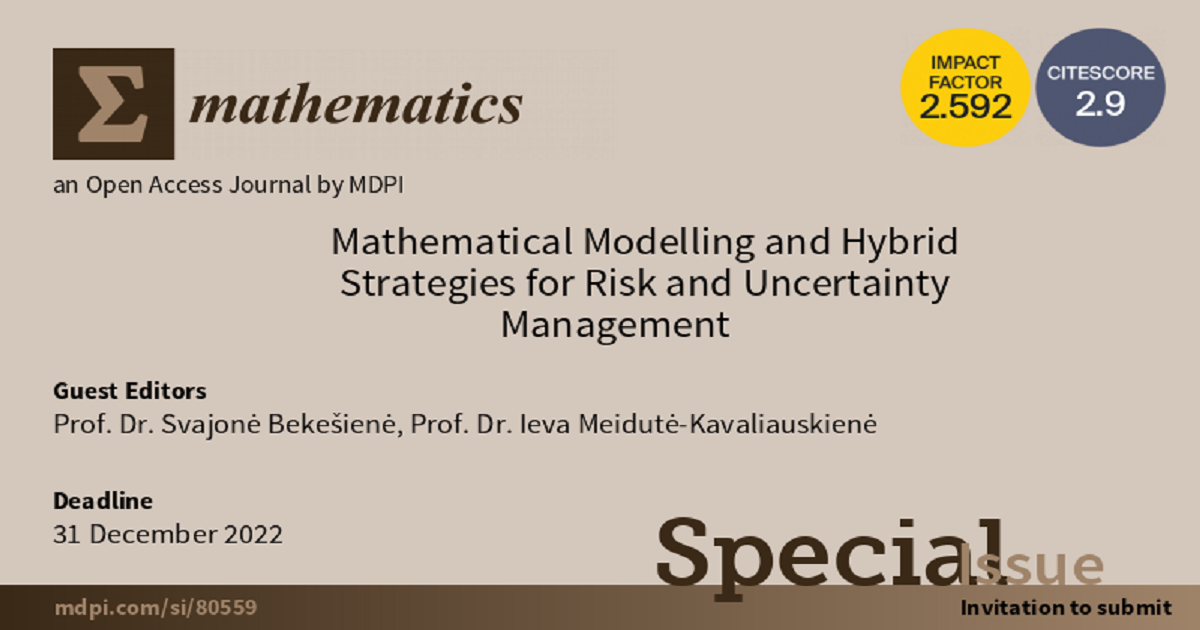Mathematical Modelling and Hybrid Strategies for Risk and Uncertainty Management
A special issue of Mathematics (ISSN 2227-7390). This special issue belongs to the section "Mathematics and Computer Science".
Deadline for manuscript submissions: closed (31 December 2022) | Viewed by 12081

Special Issue Editors
Interests: multi-purpose decision-making tasks; mathematical modeling; advances in theoretical mathematics and statistics (structural equation modeling); fuzzy logic; risk assessment and management
Special Issues, Collections and Topics in MDPI journals
2. Business Management, Vilnius Gediminas Technical University (VILNIUS TECH), Sauletekio al. 11, LT-10233 Vilnius, Lithuania
Interests: logistics; supply chain management; modelling; integrating processes; 3 PL
Special Issues, Collections and Topics in MDPI journals
Special Issue Information
Dear Colleagues,
Risk management is a decision-making process that takes into consideration political, social, economic and engineering factors, with relevant risk assessments relating to a potential hazard. Mathematics uses reasoned theories, computational techniques, algorithms, and the latest computer technologies to solve the problems arising from various fields, such as economics, engineering, business and social sciences. Mathematics also focuses on problems coming from the industry, and creates solutions relevant to the industry, including finding the most efficient and cost-effective way to solve these problems. It allows the development, analysis and comparison of regulatory options, as well as the selection of the optimal regulatory response for safety from that hazard.
Reliability engineering and risk management have been attracting increasing amounts of attention, and are of growing importance in civil, mechanical, aerospace and aeronautics, offshore and marine engineering, as well as in many other disciplines of engineering. Against this background, the aim of this Special Issue is to bring scientists all over the world together to present their research on innovative methodologies, and the practical applications of these technologies in the field of reliability engineering and risk management. Emerging concepts, as well as the state of the art and novel applications of reliability principles and risk-based decision-making in all types of structures, infrastructures and mechanical systems, will be emphasized within the scope of the issue. In this context, articles on theories, methods, algorithms and applications are all welcome.
This special issue focuses on the characterization of uncertainties and the development of risk assessment models for the essential infrastructures in different areas of life. Both practical applications for reliability-based design code calibration and quantitative risk assessment, and novel methodological developments, including emerging areas, such as machine learning and artificial intelligence, are included to provide a reliable method for multifaceted risk assessment. We invite you to contribute and submit your latest research work.
Prof. Dr. Svajonė Bekešienė
Prof. Dr. Ieva Meidute-Kavaliauskiene
Guest Editors
Manuscript Submission Information
Manuscripts should be submitted online at www.mdpi.com by registering and logging in to this website. Once you are registered, click here to go to the submission form. Manuscripts can be submitted until the deadline. All submissions that pass pre-check are peer-reviewed. Accepted papers will be published continuously in the journal (as soon as accepted) and will be listed together on the special issue website. Research articles, review articles as well as short communications are invited. For planned papers, a title and short abstract (about 100 words) can be sent to the Editorial Office for announcement on this website.
Submitted manuscripts should not have been published previously, nor be under consideration for publication elsewhere (except conference proceedings papers). All manuscripts are thoroughly refereed through a single-blind peer-review process. A guide for authors and other relevant information for submission of manuscripts is available on the Instructions for Authors page. Mathematics is an international peer-reviewed open access semimonthly journal published by MDPI.
Please visit the Instructions for Authors page before submitting a manuscript. The Article Processing Charge (APC) for publication in this open access journal is 2600 CHF (Swiss Francs). Submitted papers should be well formatted and use good English. Authors may use MDPI's English editing service prior to publication or during author revisions.
Keywords
- Bayesian methods
- Damage analysis and assessment
- Decision analysis
- Nonlinear models
- Stochastic dynamics and controls
- Structural health monitoring
- Risk assessment models
- Socioeconomic aspects of resilience and sustainability
- Maintenance strategy based on risk cost optimization






